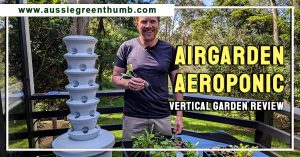When it comes to choosing the best plant humidifier, there’s only really one important factor; how often can you be bothered to top up the water?
All plant humidifiers do exactly the same job. They all turn water in an aerosol, suspended in air, ready to float around the room until it lands on the leaf of a plant. It’s an incredibly simple process, and therefore very hard to distinguish between a good humidifier, and a bad humidifier.
In this article, we’ll talk through how, why, and when to use an air humidifier, but also break down the basic difference between different types, and when you’re going to need a big air humidifier, or a mini air humidifier – because both will, in simple terms, do the same job.
More...
Best Value


Product | Our Rating | Price | |
|---|---|---|---|
1. Lovantine Rotary Planet Air Humidifier |  |  | |
2. Arovec 4L Cool Mist Plant Humidifier | 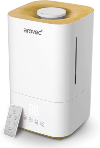 | ||
3. SmartDevil 500ml Small Plant Humidifier | 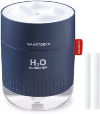 |
Plant Humidifier Buying Guide
What are Plant Humidifiers?
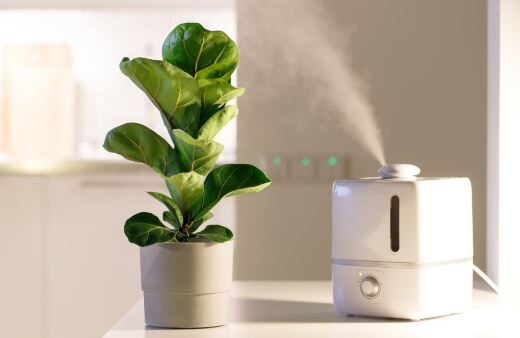
Plant humidifiers are no different to room humidifiers, but they are usually sold in slightly better looking forms. Their job is to recreate humid forest floors, especially with plants like orchid cymbidiums and bromeliads in mind that rely entirely on humidity to survive and to flower.
Learn more about bromeliads by reading our ultimate how to grow and care bromeliad guide.
The big benefit of plant humidifiers is that they take the work out of plant care for you, the gardener. Humidifying plants used to mean carrying pressurized spray bottles around the house once a week and misting each and every plant that needed it.
It also ran the risk of spreading bacteria between plants from dirty nozzles, and dirty bottles. The beauty of humidifiers is that they work through a wick filter, which reduces the amount of contaminants in the water that gets vaporized into the room too.
So as well as misting your plants automatically, humidifiers actually help prevent bacteria spreading between them.
How do Plant Humidifiers Help Plants?
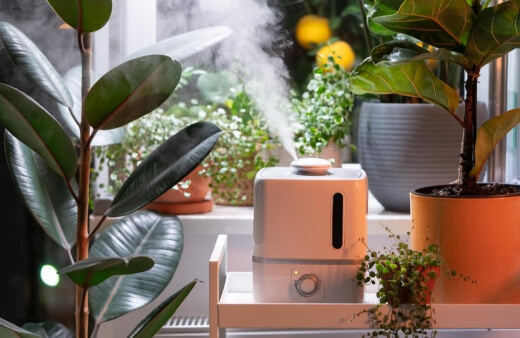
House plants have much different needs to outdoor plants, and require a certain amount of human intervention to recreate their natural habitat.
Our predisposition to fill our homes with tropical and subtropical plants means that we’re taking plants that have evolved to put on incredible floral displays, or dazzle wildlife with eye catching leaf markings to help them stand out in crowded forests, and putting them in dry, air conditioned, homes.
Humidifiers help regulate the moisture levels in the air to prevent plants drying out, particularly in the warmer parts of Australia where we can reach temperatures way above what these shade loving forest plants can tolerate.
Some plants can rely entirely on humidity to feed their leaves too, like epiphytic mosses, orchids and bromeliads that gather moisture from the air rather than from their roots, which are designed entirely for clinging to trees.
What Plants Need Humidifiers?

Do Tropical Plants Need Humidifiers?
Tropical plants, like orchids don’t need humidity to replicate their natural environment, but if they are in a warm environment without regular water, in ways that don’t properly mimic their natural habitat, humidity can help them reduce water loss, and prevent pests like spider mites from clinging to dry leaves.
Do Subtropical Plants Need Humidifiers?
Subtropical and rainforest plants need humidifying. These plants typically include epiphytes and foliage plants that like free draining soil and dry conditions, but visibly lose water through their leaves in early mornings and late evenings.


Get Your Free Guide:
Master Growing Australian Natives eBook
A Must Have Complete Guide for Every Australian Garden
Get Your Free Guide:
Master Growing Australian Natives eBook
A Must Have Complete Guide for Every Australian Garden
The plants require humidity to regulate their water levels, and to replicate their natural habitat.
Do Equatorial Plants Need Humidifiers?
Equatorial plants don’t usually need humidity but there are some plants that benefit from humidity as rainfall is typically pretty low. What they can suffer with is a poor balance of water though, leading them to lose water through transpiration.
You’ll notice desert cacti shriveling up rather than burning in full sun. This can sometimes be helped with access to humidity.
Do Succulents Need Humidifiers?
You should avoid humidifying succulents where possible. Water spots can cause dry patches on their leaves so regular access to high humidity can damage their leaves.
Succulents are designed to store their own water in their leaves, so don’t like extra moisture if it can be avoided. There is no harm in misting them occasionally to clean off dust.
What to Look for When Buying a Plant Humidifier
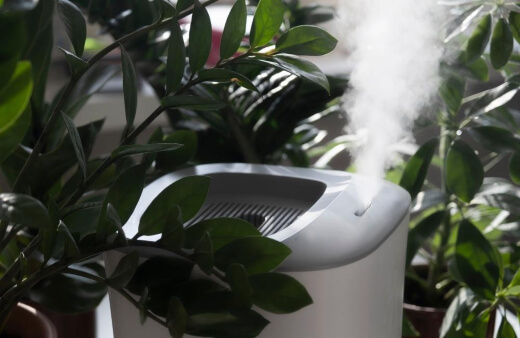
Capacity
Plant humidifiers all spray pretty even amounts of water around the room when they are misting, so the question isn’t over the volume of water in the atmosphere, but how long you need to go between refilling a humidifier.
You can buy whole room humidifiers, which will last up to a month, with a 5 gallon capacity, or more modest humidifiers that sit on a shelf or side table that holds 4-5 liters, but my personal favorite are the more decorative mini-humidifiers that can be placed around the room or on a plant stand near specific plants.
They need filling up more often, but they take up less space, and are much less intrusive on a house plant display than a traditional room humidifier.
Adjustable Flow
Some humidifiers have adjustable flows on them, which can be useful if you’re worried about dampness in your home, or if you don’t want to over-humidify more delicate plants. This can be really useful as gardeners when you want to experiment with different moisture levels in a room.
More importantly though, it lets us adjust the moisture if we notice a plant is getting yellow drooping leaves or signs of a fungal infection (this is a sign that the plant is too humid and we should reduce the flow).
Equally, when a plant is visibly drying out, and leaves are getting brown edges and dropping, increasing the humidity can be a useful way to prevent further heat damage to the leaves.
How to Use a Plant Humidifier

Humid air is heavier than dry air, so it tends to fall down a room. Placing humidifiers on high shelves is a great way to evenly humidify every plant in a room, and particularly useful for greenhouse or conservatory plant growers who want to replicate forest humidity more accurately.
You’ll notice the clouds of mist forming and floating to the floor after your humidity machine has been turned on for a few minutes, and it can create a really beautiful atmosphere.
Safety Tips for Plant Humidifiers
Electronic humidifiers are usually mains powered, or rechargeable. This means that you are deliberately mixing electricity and water, in the same way as an electric iron or a kettle.
Never place humidifiers directly beneath, besides or above a plus socket. While they are operational as the moisture can penetrate the circuitry and even cause sparks. They should always be kept as far away from the sockets as their cables allow.
Plant Humidifier Reviews for 2025
1. Lovantine Rotary Planet Air Humidifier

If humidifiers were fashion statements, this would be a good one. The cool mist humidifier by Lovantine is such a clean and simple little plant humidifier, and it’s such a beautiful object too.
I personally prefer these small humidifiers, even though they only tend to hold their small tanks for a couple of days. If you’re willing to put the effort in and re-fill regularly, they take up much less space, and I think they look better too.

Pros
Cons
2. Arovec 4L Cool Mist Plant Humidifier
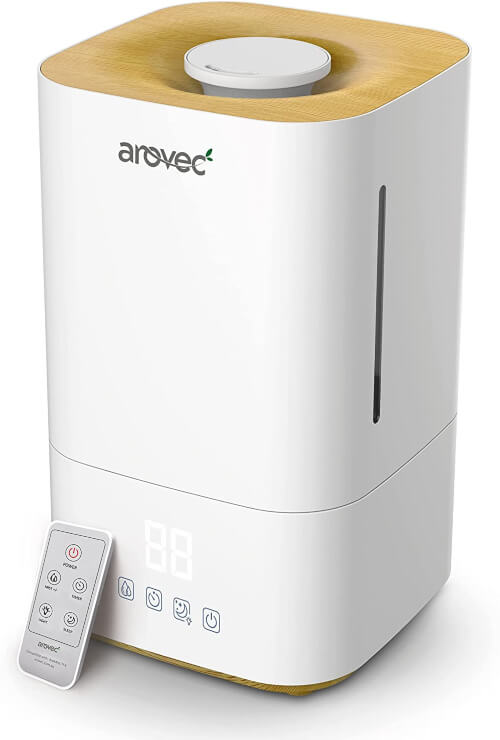
If you’re looking for a humidifier that’s going to sit comfortably in the corner of a room without looking like a big plastic box full of water, there’s something pleasantly sculptural about this design.
It’s by a completely unknown brand which would usually raise doubts, but buying through amazon means it comes with a 24 month service warranty.
The catch though, is that even though it has a great capacity, and is remote controlled to save on clumsy looking buttons, it needs to be placed on hard floors, so won’t work if you have carpets thanks to the fan being built into the base of this plant humidifier.

Pros
Cons
3. SmartDevil 500ml Small Plant Humidifier
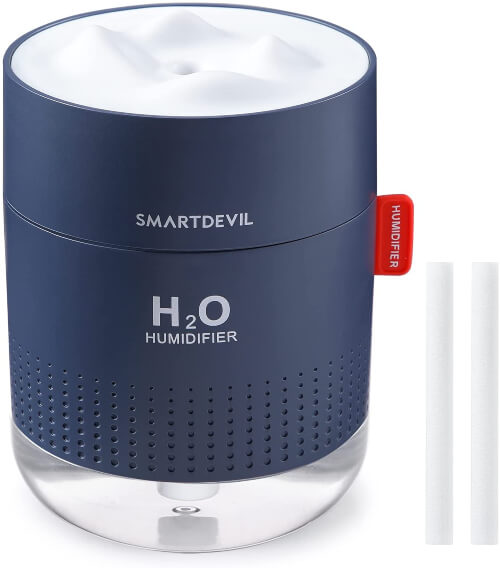
For a simple humidifier that you keep on a shelf in the conservatory or the office this is a wonderful little bit of kit. It’s simple, and definitely a budget plant humidifier, but sometimes budget is all you need when you’re just doing something simple like misting.
It doesn’t have any automation, or fancy remotes, just a mini-reservoir, and an on-off switch.
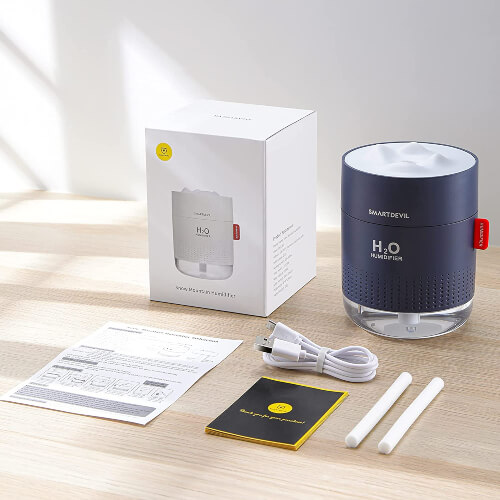
Pros
Cons
Our Plant Humidifier Top Pick
Best Value Plant Humidifier


There are so many gimmicky plant humidifiers to buy online, so it’s nice to see a mini humidifier that’s well designed and looks like whoever put it together actually considered it as an ornament in some way, because anyone who grows houseplants knows that it’s as much about making your house feel like a home, as it is about collecting and caring for the plants.
So any tools, and any kit that helps your plants should look as good as they do, and the Lovantine Rotary Planet Air Humidifier is exactly that.
Plant Humidifiers FAQs
What type of plant humidifier is best for plants?
Plants aren’t fussy when it comes to humidity, so you can use any type of plant humidifier as long as it produces neutral mists and sprays them intermittently around the room.
Humidifiers are there to support plants rather than completely define their growing space.
Are plant humidifiers worth it?
Plant humidifiers are definitely worth it if you have tropical, subtropical, or rainforest plants. By increasing the humidity in your home you reduce water transpiration, and can save huge amounts of time misting and watering epiphytic plants.
Do plants prefer warm or cool mist humidifiers?
You can buy cool mist, and warm mist humidifiers, but in my experience, it doesn’t make any real difference. While warm mist humidifiers create steam that lasts longer in the air, cool mist humidifiers create very effective aerosolized water that lasts long enough to reach and water the plants.
Can you use an essential oil diffuser as a plant humidifier?
Essential oil diffusers can be used really effectively as plant humidifiers on a budget, but because they are designed to diffuse heavily scented oils they do not create as much vapor, or propel it as far as purpose built humidifiers.
Get the Best Plant Humidifier Today
If you’re beginning to amass a tropical plant collection but you’re worried about providing the right conditions, then it’s about time you invested in a plant humidifier.
Basic humidifiers can cost as little as $20, with more extreme versions costing over $100, but for use with house plants, anywhere from $20-$70 is about the right ball-park for the best plant humidifiers.
A big, big bonus of plant humidifiers is that they actively help you as a gardener, and if you keep house plants in your bedroom, they help you sleep by raising the humidity in the air, which opens up your airways during the night.
So plant humidifiers are tools that do just as much good for the gardener as they do for the garden.

Published on February 24, 2022 by Gary Clarke
Last Updated on December 27, 2025




